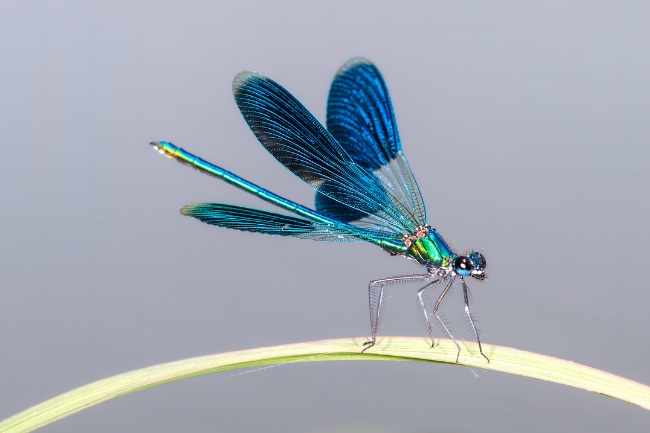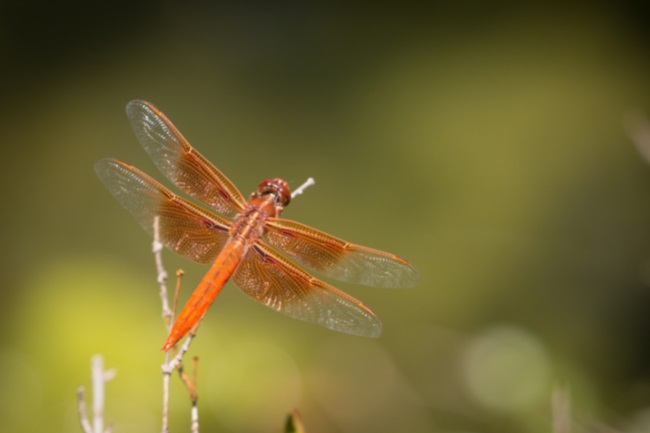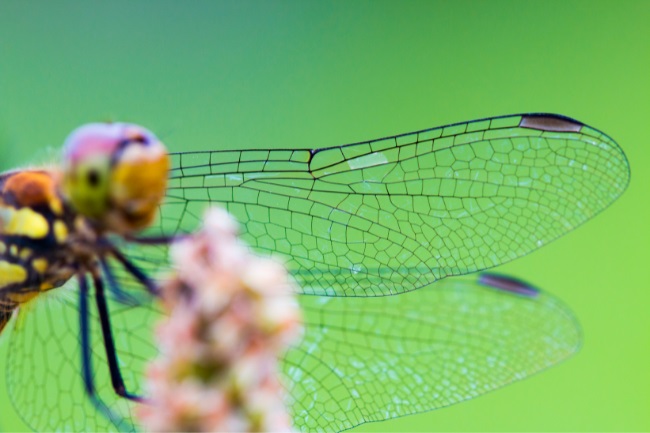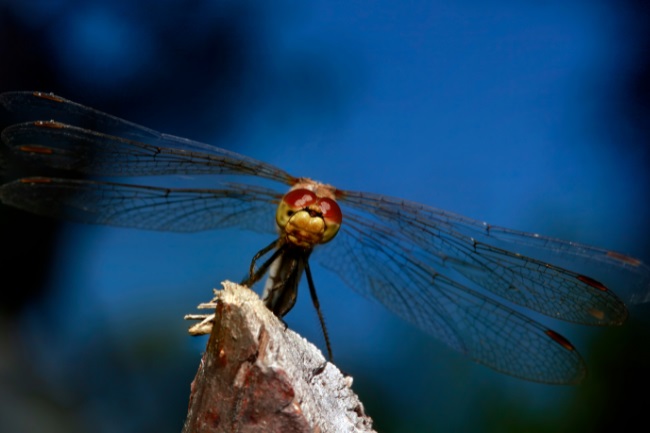Dragonflies fly by using muscles below their exoskeleton to move their four wings independently. This allows them to hover, fly backwards, and turn suddenly. It’s the amazing agility in the air that makes them such efficient hunters.
Contents
Taking to the wing

While we may think of flight as a vital aspect of a dragonflies lifestyle, it actually only becomes possible for them once they become adults. As nymphs, they live below the surface of the water, choosing to get around by swimming rather than flying.
The all-important wings are, however, always there. They are folded neatly away into little wing buds, which sit on the dragonfly nymph’s back. It is only when the juvenile dragonflies climb out of the water for the first time and break out of their skin that they have a chance to stretch their wings.
Pulling themselves out of the husks of their old selves, dragonflies cling on and must patiently wait for their wings to expand and harden. This is a particularly dangerous time for the insect, as until the wings are thoroughly dried, they can quickly become damaged or deformed. Even a waving blade of grass could result in the dragonfly never being able to take off.
| Muscle | Description |
|---|---|
| Thoracic Muscles | Powerful muscles located in the thorax (chest) of the dragonfly that control the movement of its wings. These muscles contract and relax rapidly to generate the necessary wing motions for flight. |
| Direct Flight Muscles | Muscles responsible for the up-and-down wing movement that propels the dragonfly forward and enables it to change direction quickly. These muscles attach directly to the wings and provide direct control over their movements. |
| Indirect Flight Muscles | Muscles that control the angle and positioning of the wings. These muscles are attached to the exoskeleton and work in coordination with the direct flight muscles to adjust the shape and orientation of the wings during flight. |
Across the dragonfly’s wings are a series of veins, making them look somewhat like a colourless stain-glass window. These are, in fact, hollow tubes, along which the dragonflies blood, hemolymph, can be pumped in order to open up and straighten the wings. Once they have solidified, the blood will stop pumping through them.
Now is the moment when the dragonfly can first take to the wing, heading out into the world a fully grown adult, ready to take on the world.
Also read: How Long Does a Dragonfly Live for? (Lifecycle Explained)
Why do dragonflies fly?

Many adult insects use wings to get around. For one thing, is it a much faster way of transporting themselves through the world than walking. It is also an excellent way to escape predators.
For dragonflies, the main reason they fly is to go out hunting and catch insects on the wing. Aside from hunting, dragonflies use flight to attract a mate.
Male dragonflies will fight each other in order to claim a territory in a bid to attract the most females. These clashes can seem quite dramatic when viewed from the outside, with males tumbling through the air together as they try to prove who is best suited to father the next generation. In addition, the males will often chase after females, demonstrating their athletic ability through the pursuit.
The anatomy of a wing

The wing of a dragonfly is undoubtedly very different to the wing of a bird or a bat. The translucent sheets can either be without colour or can be tinted or marked, depending on the species. Several similar species can even be identified by markings on their wings.
As well as the veins, dragonflies have a pterostigma, a denser area near the tip of their wings, usually coloured. It is thought this might be used in signalling other dragonflies, but one of its primary purposes seems to be to stop the wing vibrating as the dragonfly flies, something that would make their path much less smooth and stable.
One of the fantastic things about dragonfly wings, and what makes them particularly great fliers, is that each one of the four wings can move independently. This is because they are each attached to separate muscles. It’s this independence of movement that allows the dragonfly to be so diverse in the way it flies, being able to turn sharply, hover, and even fly backwards.
| Wing Movement | Description |
|---|---|
| Upstroke and Downstroke | Dragonflies have a unique flight pattern where the wings move independently. During the downstroke, the wings move downward to generate lift and propel the dragonfly forward. During the upstroke, the wings move upward, reducing drag and allowing for efficient flight. |
| Hovering | Dragonflies can hover in mid-air by rapidly flapping their wings, alternating between fast upstrokes and downstrokes to maintain a stable position. |
| Maneuverability | Dragonflies have exceptional maneuverability in flight. They can change direction quickly, fly backward, and even fly upside down due to their ability to control each wing independently. |
Although they are excellent fliers, they aren’t, however, particularly fast fliers. Beating their wings approximately 30 times per second, they can travel around 30 miles per hour. Many other insects are much faster fliers; however, they do not have the control of a dragonfly. It is the control and not the speed that makes them such effective hunters.
How fast can a dragonfly fly?
The speed a dragonfly flies depends in part on what species it is, with larger species often flying faster. However, a general speed of between 30 and 35 miles per hour has been found in many studies.
Can dragonflies fly backwards?
Dragonflies can fly backwards, as well as upside-down. This is due to their fantastic wing control.
Do dragonflies fly at night?

In general, most dragonflies aren’t particularly active at night, most sleeping away the time after dusk until dawn. However, there are some records of dragonflies being seen during the nighttime. This can be because they are migrating over the sea and are not able to land or because they are taking advantage of night-flying insects.
Like all insects, they do not produce their own heat, except through the movement of their muscles. Therefore it isn’t possible for them to fly when it’s too cold. If they are going to be active at night, it will need to be a particularly warm night to make up for the lack of the sun to warm them.
How high can a dragonfly fly?
Many insects have been found to fly up into the jet streams, high above the ground, in order to travel quickly between destinations. It is possible that dragonflies, particularly migrating ones, do similar. However, most of the time, dragonflies will stay pretty low, hunting where most of their prey is gathered, above ponds or hedgerows, or even over the crowns of trees.
What can we learn from dragonflies?
The way a dragonfly flies is extraordinary. Their ability to turn quickly, alter their direction of flight, and move between different styles of flying, is a marvel of nature. So it’s no wonder humans have long studied dragonflies wings to try and find ways to copy this ability and turn it into the technology we can use so that we too can be masters of the sky.

